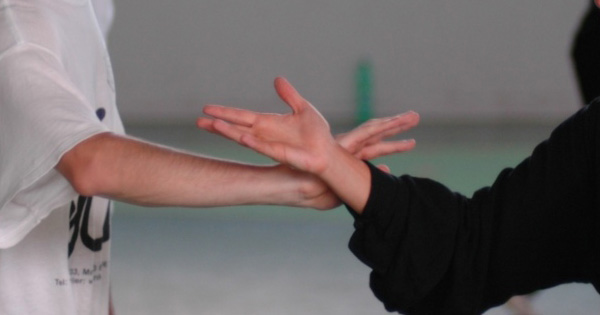Wu Yuxiang’s (武禹襄) Taijiquan (太極拳) classic states “You must act according to your opponent, not try to do things from yourself, for if you go along with your opponent, you can act spontaneously, but if you act from yourself, you will get bogged down.” and “If he takes no action, I take no action, but once he takes even the slightest action, I have already acted.” The Taijiquan classic attributed to Yang Banhou (楊班侯) says “The basic of basics is to forget about your plans and simply respond to the opponent.”
These sayings (all as translated by Paul Brennan) emphasize the predominately counter-attacking approach of Taijiquan. But does this mean that practitioners cannot initiate actions against an opponent, and that they must wait until the opponent attacks?

In many conflicts the aggressor has an advantage since the opponent needs to be able to understand the attack and then respond. The aggressor already knows their intent, but there is a delay for the recipient since they usually cannot determine what the aggressor intends until after the aggressor initiates their attack. This delay is what Taijiquan trains to eliminate.
We want to know what the opponent intends, but not let them know our plans. By allowing the opponent to initiate the action, we can gain information about their intent. By “forgetting about your plans” the opponent cannot read or understand our intent.
“Borrowing force” is commonly practiced in Taijiquan. We want to use the opponent’s actions to defeat them, emphasizing responding to the opponent rather than initiating actions ourselves. This is accomplished through “sticking.” In order to use Taijiquan’s principle of stick and adhere, connect and follow (zhan nian lian sui 粘黏連隨) we typically want to be in contact with the opponent. Can we induce contact, or must we await an advance from the opponent before we can touch them?
What about when we are using weapons where contact is often broken? In the weapons sparring that I learned, in choreographed sparring sets, drills and free sparring, we are often separated, and we frequently attack openings even when we are not in contact with the opponent’s weapon. How then does this remain compatible with Taijiquan strategy?
There are several ways to approach these questions.
My understanding is that there are ways to interact with an opponent that do not require the opponent to initiate the actions. For example, there are sayings that refer to having simultaneously true and false attacks. We want an attack to be real, yet be able to change it into a feint, depending on the opponent’s response. This means that we attack an opening or weak area of the opponent, but when they change to respond, we can abandon our attack and change to respond to their new actions. Initiating an attack in this way can be used to connect with the opponent when they respond.
Some schools refer to the interactions of push-hands (推手 tui shou) training as being like a question and answer conversation. You supply energy (an attack or feint) towards your partner (the “question”), and listen for their response (their “answer”). Your follow-up action would depend on theirs, continuing the attack if their response is wrong or, if their response is correct, changing your action in order to “ask” another question or to respond to their counter (their “question”). The person that “asks” is initiating the interaction, but what happens afterwards depends on the partner’s response (“answer”).
This type of interplay reflects the simultaneous true and false attack because the follow-up depends on how the opponent responds to the initial attack. However, it does not require that one only respond (“answer”) without ever initiating (“asking”).
Some schools train to continually flow towards the opponent’s spine when attacking, like a river flowing to the ocean. Using this approach, the goal is to control the opponent’s spine as a way of controlling their stability and movements. Any blocking by the opponent is like an obstacle in the way of the water’s movement, and should be flowed around, over washed, undercut, or worn away. This is another way of maintaining a responsive initiative during an interaction.
Another quote from Wu Yuxiang (Brennan translation) is “If an opportunity comes from yourself, go ahead and shoot, but when force comes from your opponent, borrow it.” Here “shoot” likely refers to the Taijiquan principle of storing energy like drawing a bow, and then releasing the energy like shooting the arrow, and probably means, in general, to attack. This quote seems to indicate that, though it may be desirable to have the opponent move first in order to have them commit to some action that is then used against them (borrowing their force), it is not a requirement; we can still attack on our own initiative.
Those who have faced a quality modern boxing jab know how difficult it is to stick and adhere, connect and follow when the jab and the return to the guard position are both so fast. But boxing blocks are relatively stationary, especially when they are of the covering type. This means that when they initiate their attacks using a jab, they are very difficult to connect and adhere to, but when we initiate an attack from non-contact, their defense often allows us to connect with them. Once we contact the opponent, we can employ the skills that are typically trained in push-hands practice, for as long as we maintain the contact.

Leave a Reply